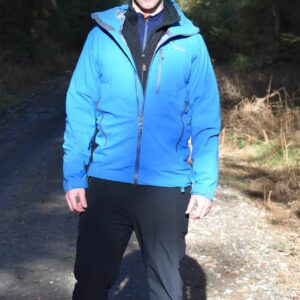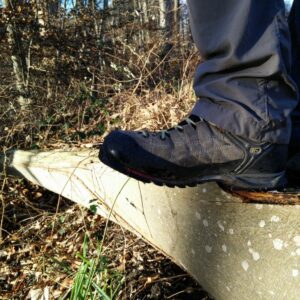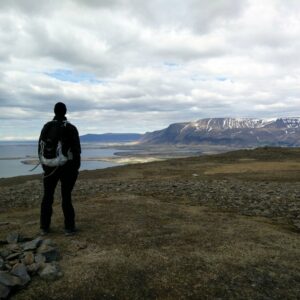
Best 5 Trails in Iceland Reachable with Public Transport
Iceland is a beautiful country with many unique and interesting landscapes, which makes it a gem for hikers of all kinds whether they prefer the toughest hills or more recreational trails around the country. However, Iceland is expensive – even compared to the States or other Scandinavian countries and not least when it comes to transport. More and more people come to Iceland for a quick stop-over, where they stay in or around Reykjavik for a weekend or less, and might not have too much of time or money to use on a hiking trip. In this case, the quite efficient public transport is by the far the cheapest way to get around (as described in our list of 10 things to know before hiking in Iceland, renting a car only pays off if you are more than one person travelling more than 90km). We have therefore made a description of how the public transport system works as well as a list of shorter hikes which can be reached by public transport from Reykjavik and Reykjanesbær – the location of the Keflavik International Airport which is the point of entry for the majority of travellers to Iceland. If you want to go directly to the suggested hikes and skip the description of the public transport system click here.
If you have any additional questions about public transport in Iceland don’t hesitate to drop us a line in the comments below.
Public transport in Iceland
How does public transport in Iceland work?
The national public transport system is called Straeto and operates yellow city busses around Reykjavik and the capital area in addition to the blue long-distance busses which largely run along the Ring road (minus the stretch between Egilsstadir and Hofn in the easternmost part of the island) as well as covering some ground on the largest and most important peninsulas such as the Westfjords, Snaefellsnes and Reykjanesbær. There is no train network in Iceland. There are also private bus companies such as Sterna, Grey Line, Reykjavik Excursions etc., but they primarily operate between Reykjavik and tourist destinations such as Gullfoss and Geysir, and are more expensive. If you want to go to the interior, however, they are the way to go – albeit only in the summer season. Go to their respective websites for more information; in the following there will be advice on how to get around with the cheaper national company Straeto.
How do I buy bus tickets in Iceland?
The island is divided into zones and thus you need one bus ticket (multi-ride, valid 75 minutes for one person) to travel within one zone (e.g. the capital area), two for travelling in two zones and so forth. One bus ticket costs 490 ISK (3.9 $; 3.2 €) to buy at the bus driver or on your Smartphone via Klappid’s app, but you can also buy a strip of 20 tickets for 9.500 ISK (74.6 $; 61.6 €) – hereby saving only a little money, but a lot of hassle as you otherwise need to have the exact amount in coins every time because the bus drivers do not give back change. When you want to use your strip of tickets, you simply pull off the amount of tickets you need for the ride and put them into the transparent plastic box (where you otherwise put in money) next to the driver. He/she will then print out a ticket for you where it says how long it is valid (usually 75 minutes per zone) and in which zones. You need to keep this ticket if you are planning to switch between several buses within the time of validity, so you can show it to the driver on your connecting ride.
You can buy the strip of tickets at the bus driver (for correct change) or at larger bus stations where there is a ticket office – in the center of Reykjavik, your best option is Hlemmur at the end of Laugavegur street. If you stay in Iceland for a longer time and intend to use the public transport system a lot, it might pay off to buy a bus pass for the duration of 1-12 months. You can only buy these bus passes at larger stations with a ticket office or online. There are also cheaper bus passes available for students – you should ask at the ticket offices for more information on eligibility, validity etc.
Bus drivers usually speak decent English and are used to dealing with tourists. In city busses there is normally a digital display showing the name of the next bus stop as well as an automatic speaker announcing it. In long-distance busses there may or may not be a display of the stops, so if you are not sure about where to get off the bus, ask the bus driver to drop you off at the right spot. Long-distance buses have fewer stops with many kilometers between them, so you might end up in the middle of nowhere if you miss your stop. City busses stop approximately every 500 meters on their route and you can always ask people on the street for directions.
Be sure to check the straeto.is website for up-to-date information on bus schedules, routes etc. when planning the transportation for your hike.
About the trails
All the trails described in the following are relatively easy, only the Helgafell trail is rated to be medium demanding as you have to walk 7km on relatively flat terrain before reaching the actual mountain of Helgafell, but it is otherwise not a difficult ascent. Reaching the top of Mount Esja can also be demanding, but there are various easier trails around the mountain side. Therefore the hikes below should be manageable for everyone

Moun Esja Trail
Mount Esja Trail
Why go there
If you are in Reykjavik, you cannot miss seeing the beautiful Mount Esja when standing on the port side Harpa as the mountain is located on the other side of the bay Kollafjordur. However, do not settle for just a look from afar! The mountain is not only popular among tourists as well as Icelanders due to its proximity to Reykjavik but also because it offers a great view on the capital and beyond. Mt. Esja is actually part of a mountain range called Esjan and thus it has numerable trails of varying length and difficulty (especially depending on season) which should satisfy all types of hikers, from families with smaller children to hardcore trail-runners. Among the peaks of the mountain range there is also possibility for some serious mountaineering. You can finish your trip with some well-earned waffles in the little café which is at the foot of the mountain, 100 meters from the bus stop.
Read more about Mount Esja Trail –>
How to go there
The bus stop where you have to get of (Esjurætur – Hiking Center) is located just within the city zone and thus you only need one bus ticket (490 ISK, multi-ride, valid 75 minutes for one person) to get there. You need to catch the blue long-distance bus 57 towards Akureyi at one of the following stations: Mjodd, Artun or Haholt. Most people travelling from center use Artun as the city busses 5, 6, 12, 15, 16, 18 and 24 also stop around here. The bus ride from Artun to the bus stop Esjurætur-Hiking Center takes approximately 20 minutes – ask the driver to drop you off at Mount Esja if you are unsure about where to get off the bus. Bus 57 runs in average once every two hours throughout the weekdays, but less frequently during weekends and in the evening – so be sure to plan your arrival and departure from the hiking site accordingly.

Hveragerdi Trail
Hveragerdi Trail
Why go there
The hot spring river near the town of Hveragerdi is a must. While many other hot springs or pools might be overcrowded, you are always sure to find a spot for yourself in the little hot river which meanders between green hills and bare cliff. You can’t reach the spring by car which helps to keep the number of visitors to a comfortable level and the hike there is quite pleasant – although it requires a pair of good hiking boots as a minimum due to the occasional steep slopes. The area around Hveragerdi is brimming with geothermal activity, so you will see steam rising many places.
Read more about Hveragerdi Trail –>
How to get there
To reach the starting point of our route in Hveragedi, you have to take long-distance bus 51 (towards Hofn) or 52 (towards Landeyjahofn) from Mjodd and get off at the Hveragerdi bus stop (located right next to a Shell gas station). The drive will take approximately 35 minutes and stretch over 3 zones (city zone included). You can get to Mjodd by city busses 2, 3 and 4 as well as the less frequent 11, 12, 17, 21 and 24; remember to get a 3-zone ticket.

Helgafell Trail
Helgafell Trail
Why go there
The trail which our GPS route suggests, will take you through some lovely diverse Icelandic landscapes just outside Reykjavik; first rolling hills down to the Hvaleyravatn lake which is a great hang-out place in warmer weather, then through a small forested area and finally reaching the bare flatland surrounding the dramatic Helgafell. This flatland is made of hardened lava and has beautiful swirls and spirals, evoking the once viscous and red-hot lava flow. The Helgafell mountain itself was created in late Ice Age when a volcano erupted under a glacier. From its top (at around 351 meters) you can indulge in a great unhindered view of the surroundings, but be sure also to admire the unique surface of the mound itself which is a mix of lava and sandstone pebbles.
Read more about Helgafell Trail –>
How to go there
The bus stop closest to the GPS route for the Helgafell trail is Vörðutorg (Vortutorg). You want to catch the bus to there from the Fjordur bus station in Hafnarfjordur (suburb to Reykjavik). Take bus line 19 towards Asvallalaug- the drive to Vörðutorg takes 10-15 minutes. The bus drives approximately four times per hour throughout the day and twice per hour in the evening. You can get to Fjordur from center by taking bus 1 towards Hfj. Vellir or bus 21 towards Miklaholt, but also the long-distance bus 55 towards the airport stops in Fjordur. As all travel is within the city zone, you will only need one bus ticket to go there and one to return.

Thorbjorn Trail
Thorbjorn Trail
Why go there
The Thorbjorn trail is especially good for those who are staying at the Blue Lagoon, Grindavik, Keflavik or elsewhere on the Reykjanes peninsula, but you can also reach it within an hour of travel from Reykjavik. If you are staying at the Blue Lagoon, you can literally step out on the trail and follow our route (even though our starting and end point is in Grindavik). The trail takes you up on the top of the volcanic Thorbjorn mound which has a great view on the Atlantic Ocean. Here you will also find the abandoned radar station of the US Navy from the time when it still had a military presence in Iceland. The trail then takes you down in a green pleasant valley and from there out on the lava fields surrounding the Blue Lagoon; all in all, a nice sample of various Icelandic landscapes.
Read more about Thorbjorn Trail –>
How to go there
The GPS trail for the Thorbjorn trail starts in Grindavik which is a small town on the south side of the Reykjanes peninsula. You can reach Grindavik from Reykjavik by first going with bus 55 towards the International Airport in Keflavik (aka FLE) or, reversely, from the airport taking bus 55 towards Reykjavik. In either case, bus 55 stops at Grindavíkurafleggjari where you will get off the bus and catch bus 88 towards Grindavik. After approximately 10 minutes of driving, you should get off at Grindavik Aðalbraut. The GPS route for the Thorbjorn trail starts 700 meters north of this bus stop. Be aware that bus 88 only runs limited times per day (in the weekend only four times), so be sure to choose an appropriate departure with bus 55 so that you won’t be stuck at the Grindavíkurafleggjari bus stop – which is literally in the middle of nowhere. Depending on where you get on bus 55 in Reykjavik, it will take you 30-50 minutes to reach Grindavíkurafleggjari; from Reykjavik to Grindavik you will altogether travel five zones (2450 ISK). If you are going from the airport, it will take you 25 minutes to reach Grindavíkurafleggjari and altogether you will travel two zones (980 ISK). You should be able to pay with credit card in bus 55, if you are straight off the airplane and low on cash.

Ulfarsfell Trail
Ulfarsfell Trail
Why go there
Ulfarsfell is a nice little mountain close to Reykjavik and is great to hike for a little recreation. You are also getting a good view of the capital and the islands in the Kollafjordur to the west as well as the small mountain tops to the north and east.
Read more about Ulfarsfell Trail –>
How to go there
The hiking trail starts just off the Vesturlandsvegur/Ulfarsa bus stop on the Vesturlandsvegur high way. You can reach this bus stop by going with bus 15 from Hlemmur towards Reykjavegur/Mosfellsbær or bus 57 towards Borgarnes/Akureyi from Mjodd, Artun or the bus stop at Kringlan shopping center. As all travel is within the city zone, you will only need one bus ticket to go there and one to return.














Hi,
My girlfriend is afraid of heights. Which would be the best for us for the most scenic experience?
Hi Greg,
you will probably get the most scenic view with the least “exposure” to heights at Mount Esja, if you go as high as the point called Steinn mentioned in the hike description. After that point, things might get a bit too steep for your girlfriend’s taste. By the way, kudos to you for taking her fear into consideration!
These look great! Do you have any recommendations for longer/more difficult hikes that are still accessible by public transit?
Thanks!
Hi David! Glad you found this article useful! Many of these suggested routes can be expanded; you can for instance roam around the various summits of Mt. Esja for a longer and more technically difficult trail. You should, however, take into consideration that some areas (both at Mt. Esja and elsewhere) can be very boggy due to the large amounts of melted snow. Besides access with public transport, water and gletsjers will be what limits your hiking routes in Iceland. People are not fussy with trespassing on private land outside the urban areas as long as you keep a respectful distance to buildings and livestock. If you are looking for a multiday hiking trip, check out our Kjolur hike, which also can be expanded as long as you make sure to begin and end the trip at the stops of the Nordurleid bus which goes there. Something similar is the very popoular and perhaps crowded Laugevegur route in southern Iceland, which Blaz did once but sadly didn’t record in full for Nail the Trail. Again, you can begin at different starting points as long as you keep to the schedule and stops of the Highland Bus line. Good luck and feel free to write again!